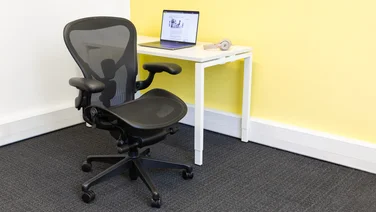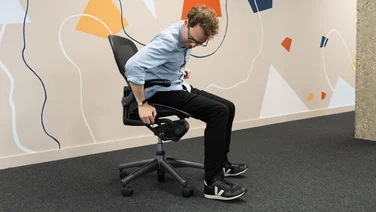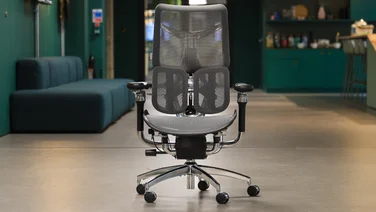To help us provide you with free impartial advice, we may earn a commission if you buy through links on our site. Learn more

In a desk-bound world, we’re often searching for the most comfortable seat to spend our days in – one that won’t cause strain, tension or injury.
Many of us look at gaming chairs as an alternative option for office work – they’re widely touted as being extremely comfortable and certainly appear to be ergonomically friendly.
That said, those who love a gaming session might think just as favourably of an office chair’s ergonomic design and adjustability.
So when it comes to the topic of office vs gaming chair, does a clear winner stand out?
READ NEXT: Best office chairs for back pain
Office chair vs gaming chair: What’s the difference?
There are a few obvious differences between an office chair and a gaming chair – and some less conspicuous ones too. We’ve looked at both chair types in terms of their appearance, structure, support, features, adjustability and comfort to help you decide which you prefer.
Appearance
The first clear difference between both kinds of chairs is what they look like.
An office chair is all about minimalism. Designed to suit a professional or corporate work environment, you’ll typically see sleek lines, elegant shapes and muted colours coming together in the form of a reclining backrest, swivel base and rolling wheels.
A gaming chair prioritises aesthetics over practicality. The shape is modelled after racing car seats, so these are usually brightly coloured with a high winged backrest and a contoured bucket seat to look flashy, modern and “cool”.
Structure and support
Office chairs prioritise a good working posture, as this helps maximise the user’s focus and productivity. That means you’re sitting with a straight back and spine with your feet planted firmly on the floor and arms parallel to the desktop with no need for straining or stretching.
The ergonomic design of an office chair naturally allows all of this positioning. Thereby avoiding back pain, carpal tunnel syndrome and other posture-related ailments. While it may feel overly stiff and rigid to sit in at first, this kind of design will provide the correct support in every crucial area.
Sitting in a gaming chair will also make you feel supported, for a few hours at least. Almost all gaming chairs feature a high back and headrest, given that they’re intended to make the user as comfortable as possible during long hours of gameplay. The chairs usually have winged sides with plenty of padding to the seat, along with padded armrests to help minimise wrist and arm strain.
As such, they support your upper and lower back and help to maintain a natural posture, but not all gaming chairs will come with all that necessary support – you need to actively look out for it.
In terms of build quality, gaming chairs are extremely sturdy. An iron or steel frame along with solid castors mean it won’t disintegrate any time soon – though this also means they’re a rather heavy addition to your workspace that could be tricky to manoeuvre around.
READ NEXT: Best budget gaming chairs
Features and adjustments
Though both chairs have adjustable features, the focus is on different areas and outcomes for the user.
An office chair’s adjustable features are all about body alignment and productivity. Being able to adjust the lumbar support, seat height, seat tilt, backrest angle and armrest width and height means someone sitting at a desk for hours on end can easily find and maintain their optimal seating position.
Office chairs usually include adjustments for:
– Recline tilt
– Seat tilt
– Seat depth
– Seat height
– Backrest angle
– Armrest height and width

In contrast, a gaming chair’s adjustable features are more about optimum comfort – which means a lot of reclining.
Gaming chairs usually feature adjustments for:
– Seat height
– Backrest recline: This is particularly impressive, often reclining to a virtually flat position – but, of course, it’s unlikely to be of any use in a productive work setting.
– Lumbar cushion height
– Headrest cushion height
– Removable lumbar and head cushions
– Armrest height and width
There are also some flashy options – built-in speakers, vibration motors and even models with footrests attached. These probably appeal to a sedentary-focused gamer, but may be redundant for an office worker.
Comfort
With all the above in mind, which kind of chair is the most comfortable?
An office chair is ergonomically designed for all-day comfort. It’s specifically intended to support your body so that aches and pains are prevented.
A gaming chair, while comfortable enough for a few hours in front of the screen, is more about spending short bursts of time in front of a screen. The padding is about slouch-style comfort, rather than being supportive in the right places for extended periods.
READ NEXT: How to adjust your office chair
Office chair vs gaming chair: Which should you buy?
Both types of chairs have a wide range of prices, with those at the upper end winning out in terms of longevity, construction, length of warranty and comfort.
You can find good value office chairs at around £200-250, but the majority will sit in the £400-600 range. Above this, your higher-end options will be veering into £800 territory and beyond (the Herman Miller Aeron is currently £1,359).
A budget gaming chair could cost around £200 or under, with a decent mid-range option costing between £200-400 – like the Noblechairs Legend TX at £380. The most expensive gaming chairs cost over £400 and custom massage-equipped models can even run into the thousands.





